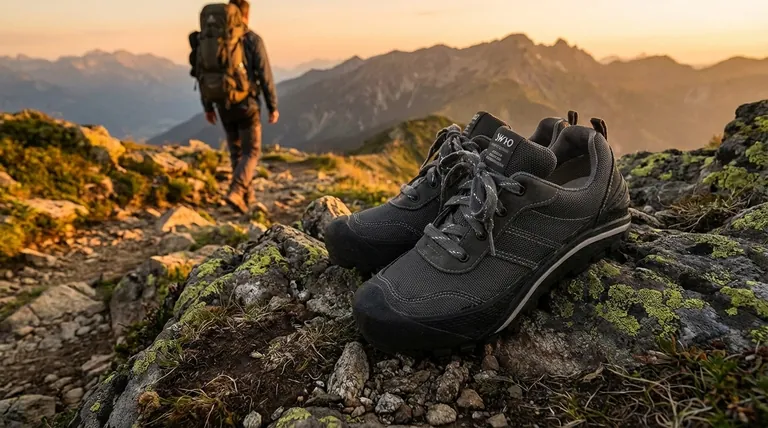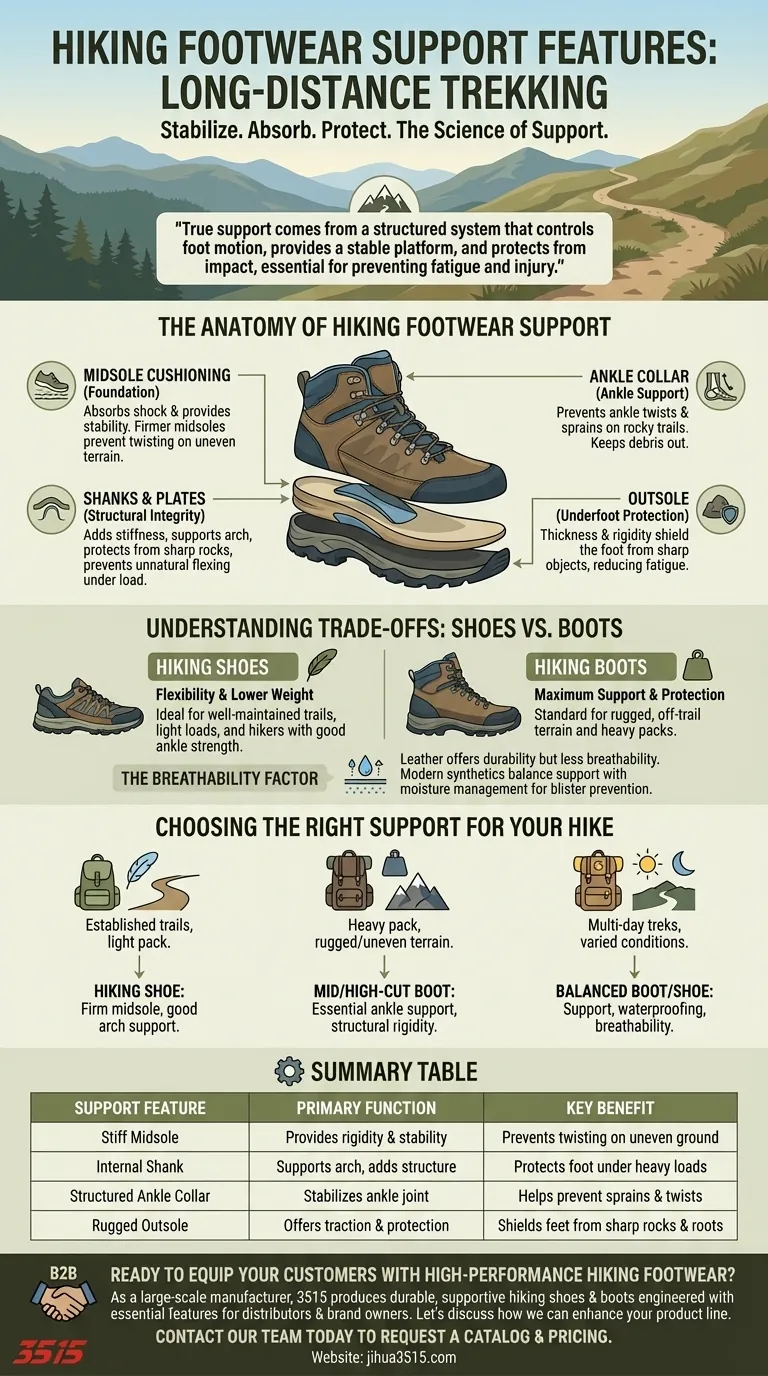For long-distance hiking, footwear offers support through a combination of structural components designed to stabilize your foot, absorb impact, and reduce fatigue. Key features include stiff midsoles with internal shanks for rigidity, cushioned footbeds for shock absorption, structured ankle collars for stability, and rugged outsoles that protect your feet from the terrain. These elements work together to prevent the repetitive stress injuries that can occur over many miles.
The crucial insight is that "support" in hiking footwear isn't just about soft cushioning. True support comes from a structured system that controls foot motion, provides a stable platform on uneven ground, and protects you from impact, which is essential for preventing fatigue and injury on long-distance treks.

The Anatomy of Hiking Footwear Support
To understand how hiking shoes and boots protect you, we need to look at their core structural components. Each piece plays a distinct role in creating a supportive system for your foot.
The Foundation: Midsole Cushioning
The midsole is the layer between your foot and the rugged outsole, and it's the primary source of cushioning and stability. It's typically made from EVA (ethylene vinyl acetate) or polyurethane.
While cushioning absorbs shock, the stiffness of the midsole is equally important. A firmer midsole prevents the shoe from twisting on uneven terrain, providing a more stable platform for your foot.
Structural Integrity: Shanks and Plates
Hidden inside the boot between the midsole and outsole is often a shank. This is a semi-rigid insert, sometimes made of steel, plastic, or a composite material.
Shanks add stiffness to the boot, protecting your foot from sharp rocks and supporting your arch. This is especially critical when carrying a heavy backpack, as it prevents your foot from flexing unnaturally under the load.
Ankle Support: The Role of the Collar
This is the most visible difference between hiking shoes and boots. A mid or high-cut boot has a collar that extends above the ankle.
This collar provides mechanical support that helps prevent ankle twists and sprains, a common injury on rocky or uneven trails. It also helps keep debris and water out of your footwear.
Underfoot Protection: The Outsole
The outsole is the rubber layer that contacts the ground. While its primary job is traction, its design is also a key support feature.
The thickness and rigidity of the outsole shield the sole of your foot from sharp rocks and roots. This protection significantly reduces foot fatigue over a long day of hiking.
Understanding the Trade-offs: Shoes vs. Boots
The level of support you need involves a direct trade-off between protection and weight. The choice between a lighter hiking shoe and a more robust boot is fundamental.
Hiking Shoes: Flexibility and Lower Weight
Hiking shoes are lighter and more flexible than boots. This means you expend less energy with each step, which adds up significantly over a long distance.
They are ideal for well-maintained trails, lighter pack loads, and for hikers who do not have a history of ankle injuries.
Hiking Boots: Maximum Support and Protection
Hiking boots offer superior ankle support and greater structural rigidity. They are the standard choice for navigating rugged, off-trail terrain or when carrying a heavy pack for multiple days.
The added stiffness and protection come at the cost of increased weight and reduced flexibility.
The Breathability Factor
Heavier, all-leather boots often provide the most support and durability but are typically less breathable. Modern synthetic shoes and boots can offer excellent support with better moisture management, which is critical for preventing blisters on multi-day trips.
Choosing the Right Support for Your Hike
Your ideal footwear depends entirely on the terrain, the weight of your pack, and your personal biomechanics.
- If your primary focus is covering distance on established trails with a light pack: A hiking shoe with a firm midsole and good arch support offers the best balance of support and low weight.
- If your primary focus is carrying a heavy pack or navigating rugged, uneven terrain: A mid or high-cut hiking boot is essential for its ankle support and structural rigidity.
- If your primary focus is multi-day treks in varied conditions: Prioritize a boot or shoe with a balance of support, waterproofing, and breathability to manage foot health over the long haul.
Ultimately, the most important support feature is a proper fit that locks your heel in place and allows the footwear's engineered systems to function as intended.
Summary Table:
| Support Feature | Primary Function | Key Benefit |
|---|---|---|
| Stiff Midsole | Provides rigidity and stability | Prevents twisting on uneven ground |
| Internal Shank | Supports the arch and adds structure | Protects foot under heavy loads |
| Structured Ankle Collar | Stabilizes the ankle joint | Helps prevent sprains and twists |
| Rugged Outsole | Offers traction and underfoot protection | Shields feet from sharp rocks and roots |
Ready to equip your customers with high-performance hiking footwear?
As a large-scale manufacturer, 3515 produces a comprehensive range of durable and supportive hiking shoes and boots for distributors, brand owners, and bulk clients. Our production capabilities ensure every pair is engineered with the essential support features—like rigid midsoles, protective shanks, and stable ankle collars—that long-distance hikers demand.
Let's discuss how our footwear can enhance your product line and meet the needs of serious hikers. Contact our team today to request a catalog and pricing.
Visual Guide

Related Products
- Durable Rubber Sole Outdoor Shoes Wholesale & Custom Manufacturing
- Durable Waterproof Rain Boots | Custom Manufacturer for Wholesale & Brands
- Safety Footwear Wholesale Manufacturer for Custom OEM/ODM Production
- Wholesale Customizable Safety Boots Durable & Protective Footwear Manufacturing
- Wholesale Durable Safety Boots | Custom Steel Toe & Puncture-Resistant Manufacturing
People Also Ask
- How do hiking shoes or boots protect feet from environmental hazards? A Guide to Trail-Ready Footwear
- What are the characteristics of heavy-duty hiking boots? Ultimate Guide for Rugged Terrain
- What were traditional shoe soles made from before rubber? The History of Leather Soles
- Why are rubber-soled shoes considered multi-weather footwear? Unlock All-Season Traction & Protection
- Why are vulcanized soles popular in urban fashion? Discover the Legacy of Authentic Street Style



















